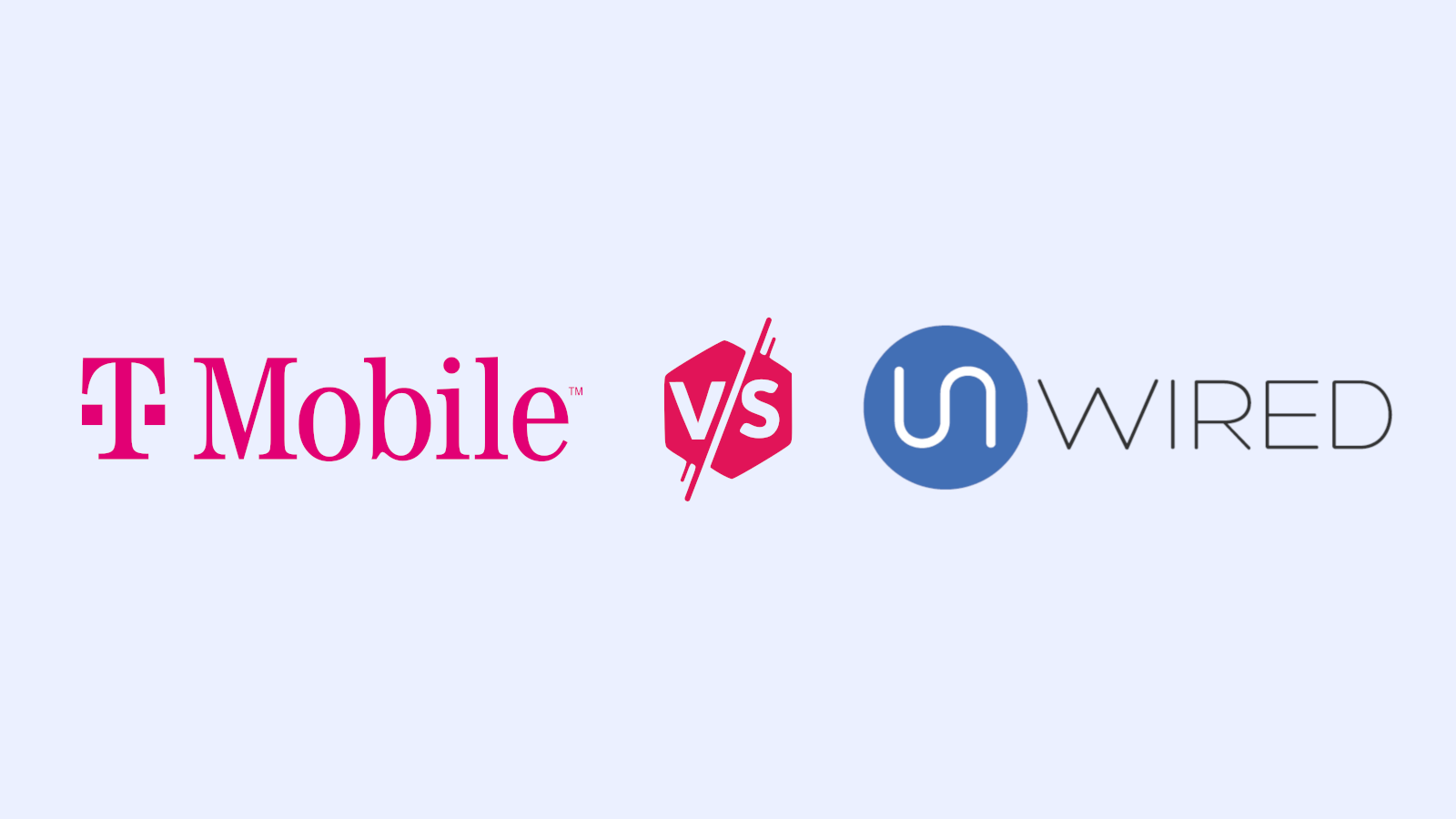What Are Hotspots and How Do They Work?
May 1, 2024 | Share
Brand Guides
Wi-Fi hotspots are a way to get online when you’re traveling or working outside your home or office. Most smartphones have built-in hotspot and tethering functions, but you can also buy a mobile hotspot device to carry around in your suitcase or bag—letting you connect to wireless speeds of 1–1,000Mbps.
We have tons of experience using Wi-Fi hotspots and reviewing them for HighSpeedInternet.com. We compiled all our resources on this page to help you learn about how hotspots work, how much personal hotspots cost, and more.
Read more about hotspots
Hotspots can refer to a lot of things—from the hotspot on your phone to a standalone mobile hotspot to public Wi-Fi hotspots. We cover hotspots from all angles. This list of all our hotspot coverage can help you find what you need.
Jump to other sections on this page: What is a hotspot? | Types of hotspots | How fast are hotspots? | Cell phone hotspots | Mobile hotspots | 5G hotspots | Travel hotspots | Hotspot data plans
Jump to other sections on this page:
What is a hotspot?
A hotspot is a wireless access point that lets you connect phones, tablets, computers, and other devices to the internet when you’re on the go. They’re built into most smartphones, but you can also get dedicated mobile hotspot devices that deliver faster speeds, connect more devices, and have a longer battery life than your phone. You can also find public Wi-Fi hotspots at many restaurants and public buildings.
You’ll need a mobile plan with hotspot data to connect a smartphone hotspot or personal device. Connecting to public Wi-Fi, on the other hand, is usually free but you may have to purchase a product or service to get the login info.
Hotspot devices can reach top speeds of 1,000 Mbps, but are often much slower. They usually come with limited data restrictions—unlimited data on a hotspot is very uncommon—so they’re not ideal for replacing your home internet. Still, some providers have generous service plans that let you get a lot out of a hotspot each month.
Important hotspot terminology
Here’s a quick rundown of important terms you want to be familiar with as you learn more about hotspots.
Wi-Fi: A wireless internet connection. Although the term “Wi-Fi” is often used interchangeably with the internet, technically it refers specifically to an internet signal broadcast over a piece of equipment like a router or hotspot.
Cellular network: An interconnected set of computers and transmitters that exchange internet data over radio waves and let you connect devices over a hotspot.
Hotspot: A device that gives you a Wi-Fi connection. Hotspots are built into many smartphones, but you can also buy a separate mobile hotspot, or you can access the internet through a public hotspot at a restaurant or park.
Wireless local-area network (WLAN): A set of devices (including computers, phones, printers, and TVs) that are connected over a wireless network of radio and cellular signals. A hotspot sets up a WLAN that provides Wi-Fi.
Cellular data: Digital information transmitted over a cellular network. You need data in order to use the internet, and you can get a “data plan” from a cell phone provider to make your hotspot work.
Service set identifier (SSID): A unique sequence of numbers and letters to name a Wi-Fi network. It’s basically the name of your hotspot, and you can identify it by pulling up the Wi-Fi dropdown menu on a laptop, tablet, or phone.
Put your hotspot to the test
Take our speed test to figure out what kind of bandwidth you’re getting out of your hotspot. Take it multiple times to see how your speeds are impacted by where you are and how many devices you’ve connected.
Download speed
000 Mbps
Upload speed
000 Mbps
Latency (ping)
00 ms
Jitter
00 ms
How does a hotspot work?
A Wi-Fi hotspot uses wireless data from a cellular provider to give you internet access for phones, computers, tablets, and other Wi-Fi enabled devices.
A mobile hotspot usually provides a connection over 5G or 4G LTE wireless technology, providing max speeds of around 30 Mbps. If you can get your hands on a model that supports 5G, you could enjoy speeds from 50Mbps to well past 1,000Mbps in some places.
Do hotspots work without cell service?
Hotspots don’t work without cell service. Hotspots need cellular service to create a Wi-Fi signal. So you’ll need a data plan from your cell phone company or another provider to make your own hotspot work. And you’ll also need adequate cell service.
Find home internet options near you
Hotspots are great for the road, but they can’t beat a good home internet connection. Enter your zip code to find the best options in your area.
Types of hotspots
| Hotspot type | Price | Data cap | Our pick |
|---|---|---|---|
| Phone hotspot | $1,429.96 (plus data plan) | 15–40GB/mo. | iPhone 15 Pro Max |
| Mobile hotspot | $199.99 (plus data plan) | 2 GB–100GB/mo. | NETGEAR Nighthawk M1 |
| 5G hotspot | $264.00 (plus data plan) | 2 GB–100GB/mo. | Inseego MiFi X PRO 5G |
| Travel hotspot | $99.99 (plus data plan) | Depends on provider | Huawei E5577-320 4G LTE Mobile WiFi Hotspot |
Data as of 5/1/24. Offers and availability may vary by location and are subject to change.
Amazon.com Price (as of 5/1/24). See full disclaimer.
Broadly speaking, people also often use the term “hotspot” to describe any public internet access point that gives you a Wi-Fi connection. So that includes the free Wi-Fi at an airport, restaurant, or public library.
We have more info on public hotspots in our public Wi-Fi guide.
Pro tip:
Do you want a hotspot with unlimited cellular data? Unfortunately, that’s nearly impossible—but you do have some options that come close. Take a look at the best unlimited hotspot plans.
How fast are Wi-Fi hotspots?
Most 4G LTE Wi-Fi hotspot devices hit top speeds of around 30–40Mbps.
However, speeds vary depending on the kind of hotspot you have and the cell service available. 5G hotspots reach much faster speeds, hitting 50Mbps in the lower range while topping out faster than 1,000Mbps in some urban areas (where millimeter-wave 5G is available).
Since a hotspot runs on a wireless connection, speeds can go up and down due to signal interference. That can happen if you’re far away from the nearest cell tower, and it can also be impacted by certain geographic landmarks in your area. Mountains, canyons, trees, and even bad weather can make it harder for a hotspot to pick up cellular signals.
Cell phone hotspots
A phone’s hotspot is the easiest, most affordable hotspot you can use. It comes built into your smartphone’s hardware, so you can switch it on with the tap of a button and use data straight from your phone plan (as long as your plan allows it).
You won’t always get a whole lot of data, and there’s usually a limit to how many devices you can connect—usually around 10 to 15. So this is the best way to go if you use a hotspot every once in a while. Otherwise you might want to invest in a dedicated mobile hotspot.
How do you turn on your phone’s hotspot?
Turning on a phone’s hotspot is very easy. Here’s a quick breakdown for iOS and Android phones:
Apple iOS phones and tablets:
Step 1: Go to Settings > Personal Hotspot. Or, depending on which model you have, go to Settings > Cellular > Personal Hotspot.
Step 2: Tap to toggle on Personal Hotspot.
Step 3: Switch on Allow Others to Join.
Android phones and tablets:
Step 1: Go to Settings and search for “hotspot” or “tethering.” Depending on the phone you have, it will be located in a menu titled Mobile Hotspot and Tethering, or Network and Internet.
Step 2: Tap to switch on the hotspot.
Step 3: On some phones, you’ll also need to switch on Wi-Fi sharing, which will allow the hotspot to be reached by other devices.
Once you’ve switched on your phone’s hotspot, go to the Wi-Fi menu on the device you want to connect to the internet. Look up the name of your hotspot and type in the password to connect to the internet.
In the same menu where you switch on the hotspot, you can also configure the password, network name, and other settings. And of course, make sure you’ve turned on your cellular data—the source of your Wi-Fi juice.
Specific hotspot instructions vary based on the phone you have. You can get more detailed instructions in our guide to phone hotspots.
Best cell phone hotspot plans
| Plan | Price | Hotspot data limit | Get it |
|---|---|---|---|
| T-Mobile Go5G Plus | $100.00/mo. | 50GB (then reduced to 3G speeds) | |
| Total by Verizon Plus | $50.00/mo. | 10GB/mo. of 4G LTE/5G, then reduced to slower speeds | |
| Visible+ phone plan | $45.00/mo. (after the first month) | Unlimited data with speeds up to 10Mbps |
Data as of 5/1/24. Offers and availability may vary by location and are subject to change.
*Taxes & fees included.
†Per line per month. Plus taxes & Fees.
Your phone likely already has a hotspot built in, so all you need to get the hotspot working is a phone plan that gives you hotspot data. We think T-Mobile’s Go5G Plus plan is the best you can get because it gives you a ton of data at a reasonable price.
These other plans will do great as well, although Visible’s budget-friendly plan comes with unlimited data but tight restrictions. You get only maximum 10Mbps speeds, and you can connect only one device at a time. Stick with that if you’re on a low budget.
Pro tip:
Read our full guide on hotspot data plans for more information.
Mobile hotspots
Mobile hotspots are dedicated devices that give you a hotspot connection. They’re more expensive than phone hotspots, but they work a lot better for intensive hotspot use, connecting more devices, and supporting faster speeds. You can also usually get more data for your buck from a standalone hotspot service plan than you could with a smartphone hotspot.
Most mobile hotspots run over 4G LTE and 5G wireless networks. In rural areas, these hotspots typically reach download speeds of around 25–30Mbps. In cities and a lot of suburbs, 5G speeds can be as fast as 1,000Mbps. That’s faster than you probably need, but it’s nice if you need to connect multiple laptops and tablets to the same hotspot.
Best mobile hotspots
| Best for | Product | Price | Connectivity | Max devices | Order online |
|---|---|---|---|---|---|
| Best overall | T-Mobile Inseego MiFi X PRO 5G | $264.00 | 5G (mmWave, C-band, sub–6GHz), 4G LTE, Wi-Fi 6 (802.11ax) | 32 | View on T-Mobile |
| Best Verizon hotspot | Verizon Inseego MiFi M2100 5G UW | $399.99 | 5G (mmWave, sub–6GHz), 4G LTE, 802.11ac | 30 | VIew on Verizon |
| Best AT&T hotspot | NETGEAR Nighthawk M1 4G LTE Mobile Router | $199.00 | 4G LTE, 802.11ac | 20 | View on Amazon |
| Best 5G hotspot for AT&T | NETGEAR Nighthawk M6 5G WiFi 6 Mobile Router | $649.99 | 5G (mm-wave, C-band, sub–6GHz), Wi-Fi 6 (802.11ax) | 32 | View on Amazon |
| Best budget hotspot | Alcatel LINKZONE | $83.99 | 4G LTE, 802.11n | 16 | View on Amazon |
| Best for international travel | Huawei E5577-320 4G LTE Mobile WiFi Hotspot | $99.99 | 4G LTE, 802.11n | 10 | View on Amazon |
| Best user friendly option | GlocalMe G4 Pro 4G LTE Mobile Hotspot Router | $169.99 | 4G LTE, 802.11n | 10 | View on Amazon |
Amazon.com Price (as of 5/1/24). See full disclaimer.
T-Mobile’s Inseego MiFi X PRO 5G gives you premium performance at a relatively affordable price. Able to support up to 32 devices, it delivers a solid connection over T-Mobile’s 5G and 4G networks, while its Wi-Fi 6 connectivity ensures that every device gets a stable connection. It has a powerful battery and comes with a USB-C port you can use to charge other phones and devices.
On the other hand, the Alcatel LINKZONE is a bare-bones model that gives you decent speeds (usually around 15–30 Mbps) at a truly bargain price. AT&T’s NETGEAR Nighthawk M1 has a long-lasting battery and comes with a range of security features. It also connects more devices than most hotspots, but it costs the most out of these three options. AT&T’s hotspot data plans tend to be on the pricey side too.
Pro tip:
Want to know all the specs and prices for these Wi-Fi making machines? Take a quick look at our best hotspots guide for all the details.
How well do mobile hotspots work?
Mobile hotspots work very well. Although they generally don’t give you as much speed and data as a home internet plan, they give you a reliable connection in places and situations where it’s hard to get internet access. They’re especially useful when you’re on the road a lot, working remotely in a restaurant or coffee shop, or staying in a vacation home.
Best times to use a hotspot:
- Traveling (domestically or overseas)
- Working remotely at a coffee shop or restaurant
- Living in a rural area
- Staying in a vacation home
Get a list of home internet services near you
If you’re looking for a more stable, long-term connection, you may be better off with a traditional home internet plan. Run a search to see what you can find in your area.
5G hotspots
5G hotspots are mobile hotspots that give you a connection over 5G wireless networks. There used to be rare, but are now easier to find than ever.
They’re way faster and can hit speeds faster than 1,000 Mbps (in some places). They connect a lot more devices and have Wi-Fi 6 capability—the latest Wi-Fi standard, which keeps speeds consistent for multiple users on the same connection.
A 5G hotspot isn’t necessarily a must-have—you can still get great performance out of a 4G hotspot device or phone hotspot. But with their boosted capability, 5G models are excellent picks for businesses and schools. They’re also helpful if you do a lot of high-bandwidth activities since they tap into the fastest 5G speeds.
Best times to use a 5G hotspot:
- Sharing Wi-Fi with coworkers at conferences and conventions
- Using Wi-Fi as part of a school study group
- Connecting to Wi-Fi in an urban area (where you can get millimeter-wave 5G with gigabit–plus speeds).
Best 5G hotspots
| Best for | Hotspot | Image | Price | Supported 5G bands | # of devices it can connect | Get it |
|---|---|---|---|---|---|---|
| Best overall | T-Mobile Inseego MiFi X PRO 5G | 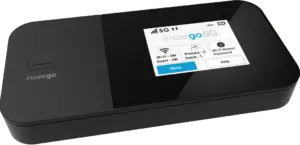 | $264.00 | • Sub-6Ghz: n2, n5, n48, n66 • C-band: n77, n78 • mmWave: n257, n260, n261 | 32 | View on T-Mobile |
| Best for Verizon customers | Inseego MiFi M2100 5G UW | 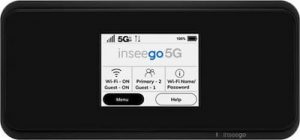 | $399.99 | • Sub-6Ghz: n2, n5, n66 • mmWave: n260, n261 | 30 | View on Verizon |
| Best for AT&T customers | NETGEAR Nighthawk M6 Pro | 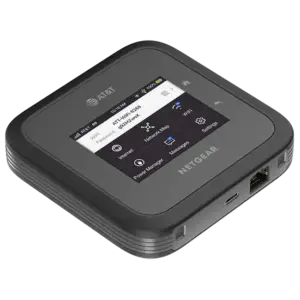 | $459.99 | • Sub-6GHz: n2, n5, n12, n14, n30, n66 • C-band: n77 • mmWave: n260 | 32 | View on AT&T |
Data as of 5/1/24. Offers and availability may vary by location and are subject to change.
T-Mobile takes the cake when it comes to 5G hotspots. The Inseego MiFi X PRO 5G is the ultimate hotspot device, with tons of features and powerful capabilities at an affordable price. On top of that, you can also get a flexible and generous data plans from T-Mobile, with prices starting at $10 a month for 2GB and going up from there.
Verizon and AT&T both have great 5G hotspot contenders—the only catch is you have to pay more for most of the same features.
Pro tip:
Want to know more about these 5G devices? Take a look at our best 5G hotspots page.
Travel hotspots
Technically, all hotspots work for traveling. But some hotspots are designed specifically for traveling internationally, giving you Wi-Fi either through a special data plan or via a SIM card from a local provider.
If you’re on a budget, it’s best to use your cell phone’s hotspot while abroad—that way, all you have to do is swap in a local SIM card to get data. But consider paying extra for a standalone hotspot device if you plan to use a hotspot regularly and don’t want to deal with finding SIM cards or working with international cell companies.
Best travel hotspot
| Product | Image | Price | Max devices | Data plan | Get it |
|---|---|---|---|---|---|
| Huawei E5577-320 4G LTE Mobile WiFi Hotspot | 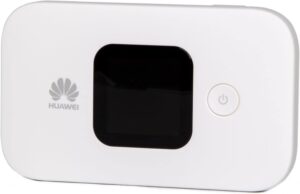 | $99.00 (plus data plan) | 10 | Depends on service carrier | View on Amazon |
Amazon.com Price (as of 5/1/24). See full disclaimer.
You can get easy Wi-Fi at any time with one of Huawei’s travel hotspots, which works with SIM cards from cellular carriers in Europe, Asia, the Middle East, and Africa.
Hotspot data plans: Can you get unlimited hotspot data?
You need a data plan to use a hotspot. So here’s the bad news first: you usually cannot get unlimited high-speed hotspot data. Cellular providers simply aren’t as generous when it comes to internet data, so the vast majority of hotspots come with relatively strict service plans.
But you still have some solid options when it comes to getting a hotspot data plan. The best data plans cost more than $50 per month for 40–100GB of data. Some plans let you buy a smaller amount of data upfront for a lower monthly price, saving you money if you use a hotspot only once in a while.
Best hotspot data plans
| Plan | Price | Data allowance | Get it |
|---|---|---|---|
| T-Mobile 2GB | $10.00/mo.* | 2 GB/mo. (can order more GB w/ data pass) | |
| Verizon Unlimited Plus | $20.00–40.00/mo. | 50 GB of 4G LTE/5G, then reduced to 600 Kbps | |
| AT&T 50GB | $55.00/mo. | 50GB | View Plan |
Data as of 5/1/24. Offers and availability may vary by location and are subject to change.
Our top mobile hotspot plan is T-Mobile’s 2GB plan. It gives you 2GB of data for $10 a month. If you run out, you can get a “data pass” to buy more data. We like this one because it’s really affordable and gives you more flexibility, since you don’t have to commit to a bunch of data at a high price upfront.
You can get 50GB of hotspot data from AT&T for $55 per month. And Verizon is no slouch on the hotspot front either, offering a range of hotspot plans with generous data options at competitive prices.
Pro tip:
Although unlimited data isn’t easy to find with hotspots, you can find some unlimited wireless internet options with all the data you need.
Disclaimer
Product prices and availability are accurate as of the date/time indicated and are subject to change. Any price and availability information displayed on Amazon.com at the time of purchase will apply to the purchase of this product. HighSpeedInternet.com utilizes paid Amazon links.
CERTAIN CONTENT THAT APPEARS ON THIS SITE COMES FROM AMAZON. THIS CONTENT IS PROVIDED ‘AS IS’ AND IS SUBJECT TO CHANGE OR REMOVAL AT ANY TIME.
Author - Peter Holslin
Peter Holslin has more than a decade of experience working as a writer and freelance journalist. He graduated with a BA in liberal arts and journalism from New York City’s The New School University in 2008 and went on to contribute to publications like Rolling Stone, VICE, BuzzFeed, and countless others. At HighSpeedInternet.com, he focuses on covering 5G, nerding out about frequency bands and virtual RAN, and producing reviews on emerging services like 5G home internet. He also writes about internet providers and packages, hotspots, VPNs, and Wi-Fi troubleshooting.
Editor - Cara Haynes
Cara Haynes has been editing and writing in the digital space for seven years, and she's edited all things internet for HighSpeedInternet.com for five years. She graduated with a BA in English and a minor in editing from Brigham Young University. When she's not editing, she makes tech accessible through her freelance writing for brands like Pluralsight. She believes no one should feel lost in internet land and that a good internet connection significantly extends your life span.

